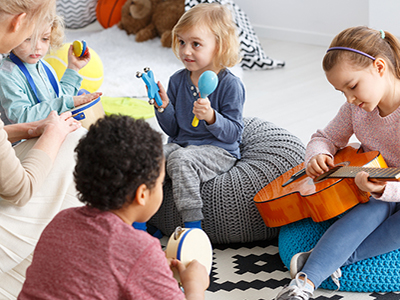
Music In Bloom
Open the Circle
by Maureen Conlin
When children sing songs that allow them to have input, they become engaged and excited. Creating these magical moments through songs and instrument play opens the circle of communication with young children.
An activity that mentions a child’s name or asks children to share their name with others is a way of opening that circle of communication. Children sit in a circle and use a small drum to find the rhythm or beat of their name, then tap that rhythm for the other children. Example: “Isabella” has four beats, one for each syllable. Isabella says her name, then taps four beats on the drum. Each child in the circle has the opportunity to participate and can even add other children’s names to hear how musical their names sound together.
Using a child’s name in a song is another way to involve them. For instance, the song “Willobee, Wallobee” can be expanded with verses that incorporate names as well as movement. This engages the children as active participants in the song and gives them the opportunity to feel special. Ask the children for their suggestions of movements to use: marching, jumping, walking, dancing, and so on.
Willobee, Wallobee Woo, an elephant smiled at you.
Willobee, Wallobee Wee, an elephant smiled at me.
Willobee, Wallabee Wason, an elephant jumped with Jason.
Willobee, Wallobee Watrick, an elephant jumped with Patrick.
The nursery rhyme “Hickory Dickory Dock” can involve children if they are asked how they would go up the clock. Children tap on wood blocks, starting with a steady beat to the nursery rhyme and then mimicking the sound of the mouse going up the clock, either fast or slowly.
Hickory dickory dock, the mouse went up the clock.
The clock struck one! The mouse ran down,
Hickory, dickory dock!
Hickory dickory dock, Caitlyn went up the clock.
The clock struck two! What did she do?
(Ask the child if they went fast or slowly, or to demonstrate how they went up the clock)
Hickory dickory dock!
Hickory dickory dock, Maria went up the clock.
The clock struck three, what did she see?
(Ask the child what they saw)
Hickory dickory dock, tick tock!
Another way to open the circle is for children to express themselves with feelings and actions in a purposeful way. Songs that encourage the children to name emotions, or make funny sounds and faces, opens up both verbal and nonverbal communication with teachers, parents, and other children.
The familiar song, “If You’re Happy and You Know It,” can allow children to share many feelings. Instead of happy, they can sing about being sad, mad, or scared and use facial expressions or voice tones to show those feelings. Educators or parents can use simple circle cutouts with happy, sad, mad, and silly faces drawn on them to extend this activity. Each child can select a circle and sing a song expressing the feeling it portrays.
“Punchinello” (or “Punchinella”), the Americanized singing game of European origin, is a song that children can augment with feelings, funny faces, or expression in their voices.
Look who’s here, Punchinello, Punchinello,
Look who’s here, Punchinello from the zoo.
What can you do, Punchinello, Punchinello,
What can you do, Punchinello from the zoo?
We can do it too, Punchinello, Punchinello,
We can do it too, Punchinello from the zoo.
Who do you choose, Punchinello, Punchinello,
Who do you choose, Punchinello from the zoo?
Hey, whatcha doing, Punchinella, funny fella?
Hey, whatcha doing, Punchinella, funny you!
What else can you do, Punchinella, funny fella?
What else can you do, Punchinella, funny you!
We can do it too, Punchinella, funny fella
We can do it too, Punchinella, funny you!
Choose one of us, Punchinella, funny fella.
Choose one of us, Punchinella, funny you!
Instrument play provides children with the opportunity to explore sound using percussion instruments such as woodblocks, tambourines, rhythm sticks, or drums. Seat children in a circle and distribute an assortment of percussion instruments. Ask the children to explore different ways to play them. Begin the activity by singing “Who will play, who will play, who will play with me?” Child’s response: “I will play, I will play, I will play with you.”
Ask the children to communicate with each other through their musical instruments: “I’ll play a rhythm, XX XXX, then you play a rhythm, XX XXX, then we’ll play a rhythm together, XX XXX.” Each child plays their own rhythm while the other children echo the rhythm back as they all sing.
Create a fun musical experience for young children with these activities. The circle opens and children bloom when they are provided with opportunities to explore, create, imagine, and enjoy music.
What songs and activities have delighted your students? Email Maureen at happynotes@aol.com to share!